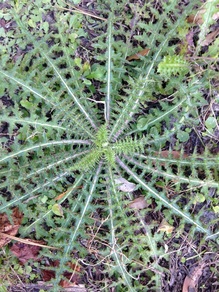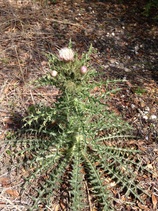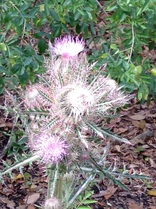 “The heart that is soonest awake to the flowers, is always the first to be touch’d by thorn" (Thomas Moore)
“The heart that is soonest awake to the flowers, is always the first to be touch’d by thorn" (Thomas Moore) Truth be told, this is is a very difficult plant to harvest for a meal because of all the prickly spines that cover the plant (bring thick garden gloves with you when you go “weeding”), and once you’re done peeling off the spiny outer layer of the leaves, you’re not left with much to make a substantial salad so it’s best to include it with your other field greens.
Culinary Use:
- If you’re brave enough to risk being pricked by the spines, you can harvest the young leaves, cut the prickles off then soak the leaves overnight in a little salted water & steam them the next day as you would any greens. This – needless to say – is a labor of love and not an easy task.
- The young flower buds can also be cooked & used as a vegetable.
- The roots are a little bland; they taste like a cross between celery and artichoke so probably best mixed in/cooked up with other with other veggies.
Reported Medicinal Uses:
- As a poultice for sore jaw or bleeding hemorrhoids;
- Steam the entire plant & use the warm infusion to steam/soak achy, rheumatic joints;
- Decoct the flower head to help treat viral infections.
Caution:
Large doses may cause vomiting and this herb is not recommended during pregnancy.
Chinese Medicinal Use:
In Chinese Medicine, different types of thistles are used to treat inflammation, stop bleed or promote urination. Japanese Thistle (Cirsium japonicum or “Da Ji”) and Field Thistle (“Xiao Ji” aka Cirsium setosum) are both used to treat chaotic bleeds such as uterine/nosebleed, vomiting blood, blood in urine or stool as well as jaundice and hypertension. The fresh herb is used topically for carbuncles, sores and swellings. You may also have heard of another type of thistle: Holy Thistle (Carbenia benedicta - yellow flowers) which is used to treat all kinds of fevers, purify the blood, treat stomach ailments and promote lactation in nursing moms. And perhaps the most easily recognized medicinal thistle is Milk Thistle (Silybum marianum), the most common medicinal thistle product found OTC/in health food stores. Milk Thistle contains a bioflavonoid complex “Silymarin” & is used to treat jaundice and other liver/spleen diseases, as well as pleurisy, snakebites, high cholesterol, and high blood sugar. This is readily available as a tea.
Well, there ya have it! Next time you’re out on your nature walk and you see this beautiful rosette or spiny plant with a gorgeous mop of purple flower heads, don’t be afraid to harvest a couple plants – just be careful. Until next time, happy Weed'n, happy Healing!
Audrey Steele, L.Ac
www.Acupuncture4YourHealth.com
“Die when I may, I want it said by those who knew me best, that I always plucked a thistle and planted a flower where I thought a flower would grow” (Abraham Lincoln)



 RSS Feed
RSS Feed
